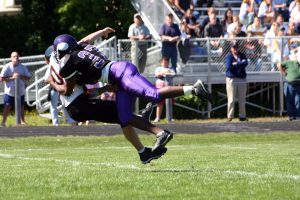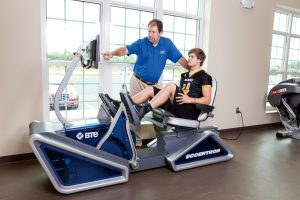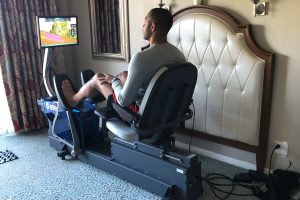
Early Specialization in Baseball – Is It Worth the Risk?
Treatment GuidelinesThe more time you spend learning a sport, the sharper your skills become. But for young athletes, especially in baseball, early specialization can actually have negative outcomes.
With the highly competitive nature of sports, young athletes who dream of playing professionally must beat some incredible odds. Many parents work hard to help their child develop their skills and get recognized for their talent. They may even encourage their child to specialize in a certain sport or skill at an early age.
Especially in baseball, early specialization is seen as a way to get ahead. Private pitching lessons, fielding lessons, hitting lessons, and personal conditioning coaches are all brought into the mix at a young age. Many of these individualized lessons start on the first day of offseason and continue until the next season begins. Some even continue during the season!
The more time you spend learning a sport, the sharper your skills become. But for young athletes, especially in baseball, early specialization can actually have negative outcomes.
What Counts as Specialization?
“Specialization” means an athlete focuses their time and efforts to one particular sport or skill. Formally, it can be defined as “intensive year-round training (more than 8 months) in a single sport at the exclusion of other sports.1”
This seems like a simple concept to understand but many young athletes may not realize they already specialize in a sport. In a study of 159 youth baseball players, 31% self-identified as specializing in baseball. But after observation, the researchers found that 83% of them specialized in the game. The athletes themselves underestimated the amount of time devoted to baseball compared to other sports2.
Why Do Young Athletes Choose To Specialize?
For many student athletes, specialization is part of their plan to make it to the college or professional level. When you look at the numbers, you’ll understand the pressure they face to gain a competitive advantage.
The chances of a high school baseball player making it to a college team are very low. According to the NCAA in 2019, there were reportedly just over 487,000 high school men’s baseball players. The number of college baseball players was only at 35,460. That means that only about 7% of high school players went on to play in college3.
Beyond college, the chances of making it to “The Show” decrease even further. Of all NCAA baseball players in 2018, only 775 of those were drafted professionally. That’s only about 2% (or 1 in 50) of NCAA baseball players advancing to the MLB level4. When considering the number of young people playing high school baseball, only about 0.15% (or 3 in 2000) of them will ever advance to professional baseball3,4.
You can see how young athletes must be extremely competitive to advance past high school teams. It’s no wonder that many players, coaches, and parents support early specialization. But, it’s important to understand the full picture and attempt to prevent some of the negative outcomes.
Pitfalls of Early Specialization
Do the benefits of early specialization outweigh the risks? To answer these questions, you can find a plethora of published articles in scientific journals that discuss the potential side effects of sport specialization in young people. Namely, the risk of injury increases with early specialization.
One study found a positive linear relationship between specialization and exposure to injury risk in high school athletes. Those who specialize in a sport for more than 16 hours per week are at greatest risk for injury5.
According to the study, baseball players hold a high risk of injury due to overuse and fatigue6. They had 4-36 times higher injury risk than athletes who specialized in other sports in the study. Specifically, pitchers are typically at the greatest risk for shoulder and elbow surgeries if they pitch for eight or more months per year or if they have pitched with arm pain or fatigue7.
One potential cause for the increased injury is the lack of diversification. For young athletes, it’s important to have a well-rounded experience to develop a broad spectrum of physical skills. Early specialization can restrict the development of neuromuscular skills that are necessary in injury prevention.
Specifically for baseball, another contributing factor is the length and frequency of the seasons. For example, a middle school player could participate in their school league, one or more summer teams, and possibly even a fall season. There is not ample time for recovery or for the athlete to participate in a non-throwing sport.
Psychological Effects of Early Specialization
One of the most important consequences of specialization that needs to be addressed is the psychological cost. Burnout affects many young people who face pressure from their parents, coaches, and others. It can occur from a combination of both physical and psychological factors8.
Young people are missing out on the type of fun activities, not related to sport, that others in their age range experience. Increased exposure to peers with other hobbies is being missed and this can have an added emotional impact on the well-being of young people.
Conclusion
If you suspect a young athlete in your program is spending too much time in one area, encourage them to take a break in the offseason. Alternatively, you can steer them towards another sport that emphasizes a different skill set. Especially for baseball, young athletes should diversify with a different sport that doesn’t involve a high volume of hitting or throwing.
Our goal as athletic trainers, coaches, or parents is to recognize and address the factors that could contribute to injury or burnout. It’s important to address those factors early to prevent negative outcomes in the future. We want our kids to continue to have fun, succeed in an activity, feel a sense of belonging and team… while retaining the physical and psychological capacity to also ‘just be kids.’
Jeff Johnson, MA, ATC
Clinical Specialist
BTE
References
- Jayanthi N, Pinkham C, Dugas L, Patrick B, Labella C. Sports specialization in young athletes: evidence-based recommendations. Sports Health. 2013;5:251-257.
- Arnold, A Thigpen C, Beattie P, Kissenberth M, Tokish J, Shanley E. Sport Specialization and Increased Injury Frequency in Youth Baseball Players: A Prospective Study. Journal of Athletic Training. 2019’ 54(10): 1115-1122.
- Estimated probability of competing in college athletics. NCAA Research. http://www.ncaa.org/about/resources/research/estimated-probability-competing-college-athletics
- estimated probability of competing in professional baseball. NCAA. http://www.ncaa.org/about/resources/research/baseball-probability-competing-beyond-high-school
- Jayanthi N, Dechert A, Durazo R, Dugas L, Luke A. Training and sports specialization risks in junior elite tennis players. J Med Sci Tennis. 2011;16:14-20.
- Myer G, Jananthi N, Difiori J, Faigenbaum A, Kiefer A, Logerstedt D, Micheli L. Sport Specialization, Part I. Does Early Sports Specialization Increase Negative Outcomes and Reduce the Opportunity for Success in Young Athletes? Sports Health, 2015: Sept 7(5) 437-442.
- Olsen SJ, Fleisig GS, Dun S, Loftice J, Andrews JR. Risk factors for shoulder and elbow injuries in adolescent baseball pitchers. Am J Sports Med. 2006;34:905-912
- Gould D, Tuffey S, Udry E, Loehr JE. Burnout in competitive junior tennis players: III. Individual differences in the burnout experience. Sport Psychol. 1997;11:257-276





